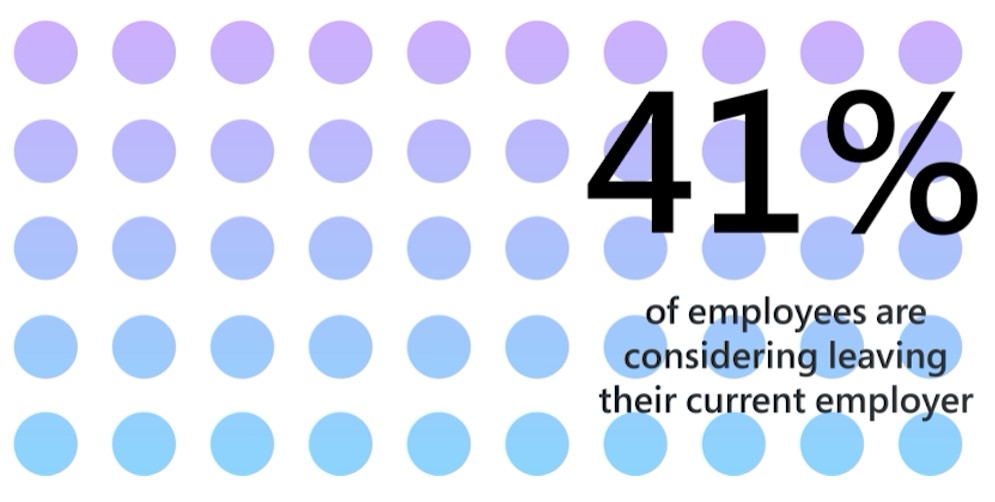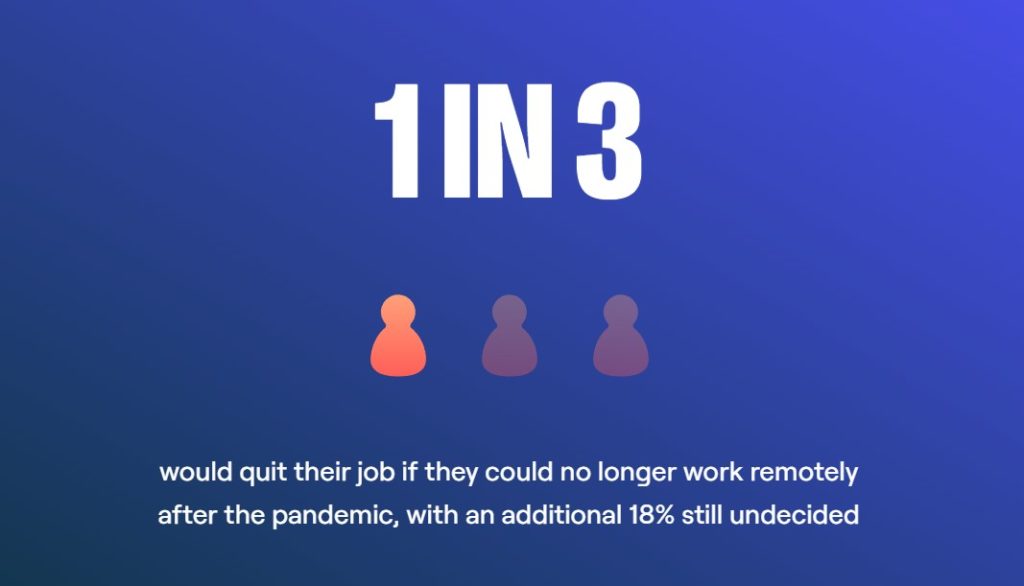Since the beginning of COVID-19, the world of work has changed—forever. Employers have to deal with an unprecedented number of challenges, including an increase in team members resigning. According to the U.S. Bureau of Labor Statistics, 4.4 million people (3% of the total workforce) left their jobs in September 2021 alone.
Working from home and exposure to a new way of life has resulted in many individuals reassessing their jobs. Some feel they’re in a toxic workplace and want out, while others question whether their current career is what they really want.
Some causes of the Great Resignation are unavoidable. However, companies can reduce the impact of this trend in several ways. Below, you’ll find out how you can avoid falling victim.

What’s the extent of the great resignation?
LinkedIn posted 5X the number of remote jobs since before the pandemic, which illustrates how unlikely it is that this trend will stop anytime soon. Earlier in 2021, research by Microsoft revealed that 41% of employees were thinking about calling it a day—permanently—with their current employer.
There are several reasons employees are quitting their jobs, or thinking about it. From feeling unappreciated to lack of progression or learning opportunities, all symptoms of a company culture in need of improvement. Many businesses expect employees to work long hours at jobs where they have little autonomy, there’s a weak company culture and connection, and unclear long-term goals. Unsurprisingly, many people question whether their expertise and skills would be valued elsewhere.
Working from home has turned the spotlight on the importance of work-life balance. Employees have shown they can be trusted to stay productive, with many employers saying productivity has remained the same or improved. This is showing many employees that it’s no longer necessary to work in the office, and they are motivated not to return to the office full-time.
How can businesses stop their employees from leaving?
1. Offer a Flexible Schedule
Many people were shifting to remote work before COVID, but the pandemic has sped things up dramatically. And once the health risk subsides, the trend will continue. According to Owl Labs’ 2021 State of Remote Work report, one in three employees said they would quit their job if they couldn’t continue working remotely post-pandemic.
The benefits of letting employees work remotely, whether full or part-time, are wide and varied. The lack of a commute and the ability to manage their own schedules allows them to balance their work responsibilities and personal life, which increases well-being—and their performance.
Some of the world’s biggest companies, including Spotify, understand the importance of keeping their best talent—and have chosen to let them work from wherever they want. This puts pressure on more businesses to follow suit to avoid losing talent to competitors who offer more flexibility.

2. Listen to Their Needs
If you want to keep your employees around for the long run, pay attention to their needs. Your team members know your operations and your products. If they’re asking for changes, it’s often an opportunity to make informed improvements that benefit your employees and your workflow.
For a company to be successful and sustainable, there must be open dialogue. Listening to team members’ needs encourages them to share their thoughts and feedback, which is crucial for developing trust. Encourage managers to get their teams together regularly to foster effective communication. Doing so will ensure that potential issues are addressed before they turn into problems.
3. Incentivize and Reward High-Performing Employees
One of the main ways to keep high-performing employees around is to recognize their achievements.
Recognize employees who go above and beyond. For instance, a pay raise or a promotion might be in order. Even words of acknowledgement go a long way. Incorporating praise and encouragement as part of your company culture creates an environment in which team members are more likely to offer due recognition to each other.
To determine who you should reward, consider how you measure performance. Sometimes, people miss things that technology doesn’t. So, use data and performance management software to ensure that key objectives are met.
By rewarding excellent performance, employees are motivated to stick around and be productive—knowing they are valued.
4. Change Your Company Culture
Having a well-defined company culture is crucial for retaining employees. It can help you recruit the right people in the first place and enable your business to reach its goals quicker. You’ll also notice that trust levels will be higher, and so will overall job satisfaction levels.
If you’re struggling to retain employees now, you’ll almost certainly suffer significantly with the Great Resignation. Team members want more than just a place to clock in and receive a paycheck; they also want to work for businesses and with people who share similar values.
To prepare for the post-pandemic world, assess your existing company culture. Ask employees what they like and what they think you should do better. It’s also a good idea to look at examples of good company culture in order to incorporate a focus on inclusion, innovation, collaboration, and flexibility to support and bring out the best in your employees.
By developing an employer brand that is engaging and supportive, you’re more likely to keep your top-performing employees and have an easier time attracting new ones.
5. Foster a Sense of Belonging
For most, having a sense of belonging is crucial to our happiness and, by extension, our productivity. Considering how much time employees spend in the workplace, fostering this in your office is critical for avoiding the Great Resignation’s impact.
Creating a sense of belonging is difficult, especially with many team members working outside the office. However, it’s not impossible. One of the easiest ways to achieve this is by letting employees speak freely and voice their opinions; 39% of participants in EY research said this helps them belong at work the most.
You can also foster a sense of belonging by regularly checking in with employees. It doesn’t need to be daily, just often enough to stay connected and keep up with their progress and frame of mind.
The Great Resignation Is a Serious issue
A full-time office job isn’t the only way for people to make money these days, nor is it necessary for achieving fulfilment. Many people have already left their positions, and if businesses don’t adapt accordingly, many of their team members will be out the door.
Preventing a mass exodus requires that companies embrace ‘flexibility’ as the growing employee demand for it is becoming a deciding factor whether to stay or leave. It also means developing a work culture in which employees are heard and valued so they are engaged and perform better.
To find out how StaffCircle can help improve your team members’ performance, request a demo.
Author Bio
Dean Mathews is the founder and CEO of OnTheClock, an employee time tracking app that helps over 15,000 companies all around the world track time.
Dean has over 20 years of experience designing and developing business apps. He views software development as a form of art. If the artist creates a masterpiece, many people’s lives are touched and changed for the better.
When he is not perfecting time tracking, Dean enjoys expanding his faith, spending time with family and friends, and finding ways to make the world just a little better.







